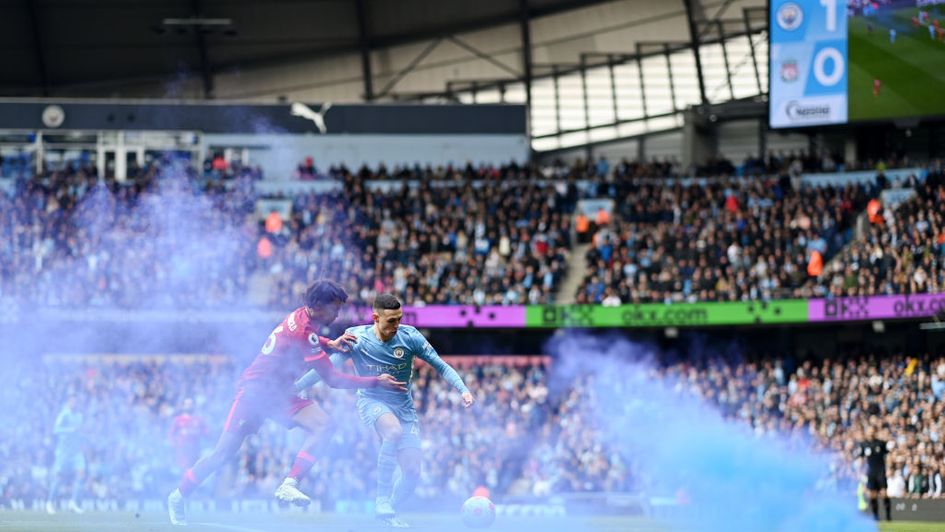Graham Ruthven reflects on a thrilling 2-2 draw between Manchester City and Liverpool, which failed to answer the question it posed: who will win the title?
In the end, the match billed as the title decider decided nothing. Just as was the case before kick-off, one point divides Manchester City and Liverpool at the top of the Premier League table. The trophy is still there to be won. One thing was confirmed, though - these are the two best teams in England, and possibly Europe, right now.
Of course, this was already a widely held belief before Sunday’s top-of-the-table clash, but the drama and intensity of their latest meeting underlined a rivalry that increasingly feels era-defining.
This, however, doesn’t necessarily mean they put on a display of high-quality football. In fact, the strength of both City and Liverpool was highlighted in the way they exposed each other’s weaknesses.
In most matches they play, City and Liverpool face opponents that have no choice than to be reactive. They must account for the strengths of the two best teams in the Premier League or stand no chance. City and Liverpool, however, don’t have to do this and backed themselves to play their own game on Sunday.
This was particularly evident in the first half when City targeted the areas behind Liverpool’s full backs. Indeed, Trent Alexander-Arnold and Andy Robertson were given a tough time as the hosts turned them as often as they could, although the positioning of Liverpool’s defensive line was so high that Manchester City had a lot of space to find.
Whether it was Joao Cancelo (who completed eight long passes, created one big chance and contributed an assist) or Gabriel Jesus (who registered more shots than any other player), City did a better job of isolating opposition defenders than Liverpool, who had the supply line to Sadio Mane and Mohamed Salah stemmed.
This was reflected in how the latter failed to register a single shot on target, although Salah did a good job of adapting his role to become a provider later in the match - see his exceptional assist for Mane’s equaliser.
Out of possession, Liverpool struggled to apply any sort of meaningful pressure which completely countered the purpose of their high line. Fabinho appeared unsettled to such an extent that he lost his bearings more than once, allowing Kevin de Bruyne and Phil Foden the pockets of space they needed to drive forward into the final third.
De Bruyne the disruptor in midfield
In particular, De Bruyne was key to the way City disrupted Liverpool in the centre of the pitch. The Belgian’s positioning between the lines (both vertical and lateral) meant Liverpool had to repeatedly break their shape to close him down which in turn created overloads and the half spaces Manchester City’s attack needs to operate. Unusually, Liverpool’s low intensity in the first period didn’t help them.
On the ball, Liverpool were similarly anaemic. Jurgen Klopp surely wanted Thiago Alcantara to control possession for spells and give his team a foothold in a contest that was always likely to get the lungs working. Without that foothold, Liverpool weren’t able to catch their breath. Instead it was City who could play at their own pace with Rodri and Bernardo Silva providing a strong platform.
Even after a strong start to the second half which saw Liverpool turn the tables on City by getting in behind their full backs to equalise, Klopp’s team couldn’t apply the pressure on the hosts’ string-pullers to make their high line work - see how de Bruyne threaded through Raheem Sterling for a disallowed goal on the hour mark and Riyad Mahrez for a stoppage time opportunity.
Fabinho and Jordan Henderson were pushed further forward in an attempt to stop Manchester City from progressing the ball so easily into the opposition half, but when the neat footwork of de Bruyne or Foden beat the press Liverpool found their backline exposed. The visitors never quite got to grips with the centre of the pitch.
Klopp to make changes ahead of FA Cup?
City and Liverpool will face each other in the FA Cup semi-finals next week and the latter will certainly need to make changes for that match. Naby Keita is a more proactive presence out of possession than Henderson and so the Guinean could come into Klopp’s team. Luis Diaz might start to provide Robertson with more cover at full back.
Pep Guardiola could potentially look to suffocate Liverpool with possession rather than try to imitate them, as Manchester City did in Sunday’s meeting.
Ordinarily, Guardiola’s teams attack small spaces and defend big ones, but they deviated from this approach and instead played the percentages. While this produced a number of opportunities and contributed to a captivating contest, it also gave Liverpool hope even when they were second best. The chance of a quick transition was always there.
There is still a long way to run in the Premier League title race, and the outcome of this match did little to give one team an advantage over the other, but City and Liverpool are so good that the true contest between them will be in the awarding of this season’s major honours. Only one can stop the other, and vice versa.
